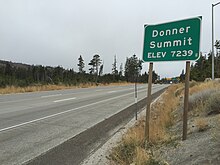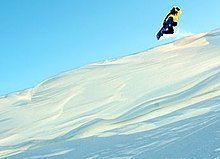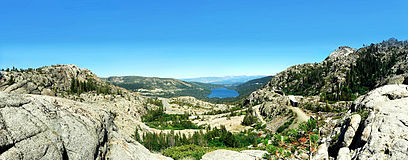Donner Pass
| Donner Pass | |
|---|---|
Sierra Nevada | |
| Coordinates | 39°18′52″N 120°19′37″W / 39.31444°N 120.32694°W[1] |
Donner Pass is a 7,056-foot-high (2,151 m)[2] mountain pass in the northern Sierra Nevada, above Donner Lake and Donner Memorial State Park about 9 miles (14 km) west of Truckee, California. Like the Sierra Nevada themselves, the pass has a steep approach from the east and a gradual approach from the west.
The pass has been used by the
Today the area is home to a thriving recreational community with several alpine lakes and ski resorts (Donner Ski Ranch, Boreal, and Sugar Bowl). The permanent communities in the area include Kingvale and Soda Springs, as well as the larger community below the pass surrounding Donner Lake.
History
To reach
On January 13, 1952, 222 passengers and crew aboard a train became stranded about 17 miles (27 km) west of Donner Pass at
Central Pacific Railroad
![[PICT:Color of original long railroad tunnel]](http://upload.wikimedia.org/wikipedia/commons/thumb/b/b9/Donner_Pass_Summit_Tunnel_West_Portal.jpg/225px-Donner_Pass_Summit_Tunnel_West_Portal.jpg)
In the spring of 1868, the

Principally designed and built under the personal, often on-site direction of CPRR's Chief Assistant Engineer, Lewis M. Clement (1837–1914),
In conjunction with major ongoing upgrades and expansions being made to the
Highways


The
Weather
Winter
The winter of 1846–47 was especially severe, contributing immensely to the disaster of the Donner Party.[citation needed]
| Climate data for Soda Springs 39.3019 N, 120.3856 W, Elevation: 6,887 ft (2,099 m) (1991–2020 normals) | |||||||||||||
|---|---|---|---|---|---|---|---|---|---|---|---|---|---|
| Month | Jan | Feb | Mar | Apr | May | Jun | Jul | Aug | Sep | Oct | Nov | Dec | Year |
| Mean daily maximum °F (°C) | 40.0 (4.4) |
40.5 (4.7) |
43.5 (6.4) |
47.8 (8.8) |
56.1 (13.4) |
65.7 (18.7) |
74.8 (23.8) |
75.0 (23.9) |
69.8 (21.0) |
58.6 (14.8) |
46.3 (7.9) |
39.0 (3.9) |
54.8 (12.6) |
| Daily mean °F (°C) | 31.3 (−0.4) |
31.2 (−0.4) |
33.6 (0.9) |
37.3 (2.9) |
44.7 (7.1) |
53.2 (11.8) |
61.4 (16.3) |
61.3 (16.3) |
56.5 (13.6) |
46.8 (8.2) |
36.7 (2.6) |
30.4 (−0.9) |
43.7 (6.5) |
| Mean daily minimum °F (°C) | 22.5 (−5.3) |
22.0 (−5.6) |
23.7 (−4.6) |
26.7 (−2.9) |
33.3 (0.7) |
40.7 (4.8) |
48.0 (8.9) |
47.6 (8.7) |
43.1 (6.2) |
35.0 (1.7) |
27.1 (−2.7) |
21.8 (−5.7) |
32.6 (0.4) |
| Average precipitation inches (mm) | 13.16 (334) |
12.26 (311) |
12.15 (309) |
6.99 (178) |
4.74 (120) |
1.57 (40) |
0.43 (11) |
0.45 (11) |
0.99 (25) |
3.89 (99) |
7.57 (192) |
14.35 (364) |
78.55 (1,994) |
| Average snowfall inches (cm) | 73.00 (185.4) |
84.20 (213.9) |
105.70 (268.5) |
41.20 (104.6) |
15.60 (39.6) |
1.80 (4.6) |
0.00 (0.00) |
0.00 (0.00) |
1.50 (3.8) |
9.90 (25.1) |
42.80 (108.7) |
69.30 (176.0) |
445 (1,130.2) |
| Source 1: PRISM Climate Group[18] | |||||||||||||
| Source 2: NOAA (precipitation & snowfall)[19] | |||||||||||||
Recreation

Sporting activities in the area include
Popular culture
The 1994 western-comedy film Wagons East features John Candy as James Harlow, the disgraced former wagon master for the Donner Party.
Albert Bierstadt's painting View of Donner Lake (1871–72) shows the view of the titular lake from the vicinity of the pass.[21]
Jack Torrance tells his family the story of the Donner Party while driving through the pass in
Donner Pass is featured in the
References
- ^ "Topographic map". CalTopo. Retrieved 2017-01-24.
- ^ Gannett, Henry. A Dictionary of Altitudes in the United States (3rd Edition), Bulletin of the U.S. Geological Survey, No. 160, Department of the Interior, Washington, D.C., 1899. p. 54
- ^ Clegg, Lee (1994). "Opening of the California Trail". High Sierra History. Archived from the original on 2007-02-22.
- ^ "Donner Party: Statistics". Utah Crossroads. Archived from the original on 2012-10-30. Retrieved 2007-09-16.
- ^ "Westward". America The Story Of Us. History Channel.
- ^ Stewart, George R. (1963). Ordeal by Hunger: The Story of the Donner Party (Third ed.). New York: Houghton-Mifflin. pp. 132, et seq.
- ^ Bull, Howard W. (January 1953). "The Case of the Stranded Streamliner". Trains & Travel. 13 (3).
- ^ "CPRR Summit Tunnel (#6), Tunnels #7 & #8, Snowsheds, Chinese Walls, Donner Trail, and Dutch Flat Donner – Lake Wagon Road at Donner Pass". Central Pacific Railroad Photographic History Museum. 2014.
- ^ Gilliss, John R. (1870). "Tunnels of the Pacific Railroad". Van Nostrand's Eclectic Engineering Magazine. II: 418–423.
- ^ "Lewis Metzler Clement: A Pioneer of the Central Pacific Railroad". Central Pacific Railroad Photographic History Museum.
- ^ Cooper, Bruce C. (August 2003). "Summit Tunnel & Donner Pass". CPRR.org.
- ^ "Newsroom". Port of Oakland. Archived from the original on 2010-11-26. Retrieved 2010-05-14.
- ^ Vantuono, William C. (November 24, 2009). "Doublestacks on Donner Pass". Railway Age.
- ^ "Donner Summit". ca.gov. Retrieved 2017-01-05.
- ^ "Grade Climb & Descent Considerations". www.gonefcon.com. Archived from the original on 2017-08-25. Retrieved 2017-08-14.
- ^ "Climate Summary of Donner Summit, California 1870–2001". Journal of the Sierra College Natural History Museum. 2 (1). Winter 2009. Archived from the original on 2013-02-24. Retrieved 2012-12-16.
- ^ "Donner Summit Snowfall and Snowpack 1879–2011". Central Sierra Snow Laboratory. University of California, Berkeley.
- ^ "PRISM Climate Group, Oregon State University". PRISM Climate Group, Oregon State University. Retrieved November 10, 2023.
To find the table data on the PRISM website, start by clicking Coordinates (under Location); copy Latitude and Longitude figures from top of table; click Zoom to location; click Precipitation, Minimum temp, Mean temp, Maximum temp; click 30-year normals, 1991-2020; click 800m; click Interpolate grid cell values; click Retrieve Time Series button.
- ^ "Soda Springs 1.5 SSW, California 1991-2020 Monthly Normals". Retrieved November 10, 2023.
- ^ "Pro Snowboarder Jamil Khan Killed by Avalanche". Mountain Zone News. 1998-02-13. Retrieved 2010-05-14.
- ^ Glenda Moore. "Albert Bierstadt Paintings". Xmission.com. Retrieved 2010-05-14.
- ^ "Donner Party". Youtube.com. May 1, 2013. Archived from the original on 2021-12-22. Retrieved 2021-04-23.
- ^ Saracevic, Al (November 27, 2012). "Hell on the Highway: The Story of I-80 at Donner Pass". Retrieved 2017-09-09.
- Powell, Margie Powell (2003). Donner Summit: A Brief History. Grass Valley, CA: Cottage Hill Publishing. ISBN 0-9658240-4-7.
External links
- Central Pacific Railroad Photographic History Museum
- 360° QTVR Panorama #2 Above Tunnel #7 Central Pacific Railroad Photographic History Museum
- Fremont's 1845 descent from the Pass Archived 2019-10-27 at the Wayback Machine Longcamp.com
- Sierra Grade Exhibit – Donner Pass Central Pacific Railroad Photographic History Museum
- Southern Pacific's City of San Francisco Stranded (1952) Central Pacific Railroad Photographic History Museum
- CalTrans webcam at Donner Summit



